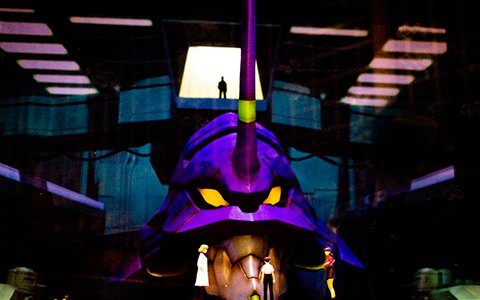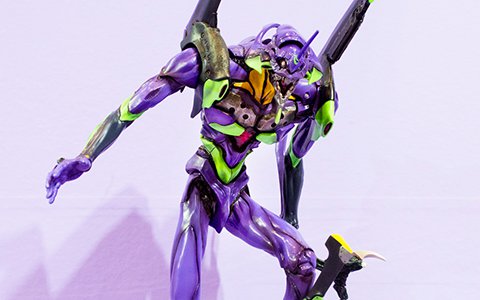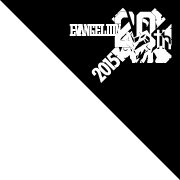The poor man’s nuclear weapons,
outstanding in both
usability and destructive power
Thus, the “Rei Ayanami in the Hospital Room” garage kit was born. The TV anime was airing just as it was launched January of ‘96, and Kuniaki Teraoka from the same company worked on the molding. There was only one Rei Ayanami being sold as an Eva garage kit in ‘95, but at the next debut, Kaiyodo revealed something that would be unexpected even from the publisher at that time.
“The merchandise wasn’t just the character’s body. Ayanami was bandaged, lying down on a bed. It included both the bed and an IV, and wasn’t a diorama, but an approach at producing a scene symbolizing that character. Of course, I didn’t instruct it, but that’s what the spontaneously born first one was. That Ayanami set Kaiyodo’s course for Eva models.”
During that same January of ‘96, Taku Sato’s Unit 01 resin kit was released. It was based on the first episode when Unit 01 tramples the angel, a unique work resembling an action figure. Even Bome, a modeller of bishoujo figures representative of Japan, was clearly improving his skills around this time with hit after hit of figures including characters like Rei Ayanami and Asuka Langley Soryu.
“As for other characteristic items, there were also the models by Shinobu Matsumura, who would later work on animal figures for the Chocolate Egg. Matsumura has always loved animals and insects. He had been known since before Eva as an animal modeller, but more people probably know his name from Eva than from animals.”
The quality of garage kits is basically determined by how a 2D anime character’s facial expression is brought to 3D without damaging it. The Unt 01 he made in ‘96, though, included an original arrangement, all the way to the feeling of the coating on the molding, and was the truly powerful work of an artist.
“The launch was shortly after the TV broadcast ended. There aren’t many other cases where such fast timing and such a bold design would be accepted by fans. You can’t usually sell works where the artist stands out so much, but it sold really well out of nowhere. Our production really resonated with the customers. Regardless, we weren’t ready for that trend at first. While the major toy manufacturers were worrying about whether or not to make plastic models or do something else, we went ahead and made resin kits, and they sold well. Assuming you mass produce plastic models, they take a lot of time and money, but with resin kits, you make one prototype. We knew that even poor people like ourselves could make a hit. There was no Gundam or Sailor Moon in Kaiyodo, but we had Evangelion. For us, Eva was like a poor man’s nuclear weapon. Easy to use, with incredible power, haha!”

“Rei Ayanami in a Hospital Bed,” the first vignette-like Eva garage kit, sculpted by Kuniaki Teraoka from the same company and released in January, ‘96.

Part of a diorama displayed in a Wonder Festival exhibit in July, 2015. This was first displayed at the popular event by the same company in ‘12, “Kaiyodo Evangelion Figure World.” You can see how their craft and the concept behind their creations have evolved since the vignette-like model from ‘96.

This is a garage kit made by Shinobu Matsumura in ‘97, resold as a finished product with “Rebuild of Evangelion” coloring. As you can tell from the feel of the thigh muscles and its facial expression, the reproduced arrangement captured the grand atmosphere of a battle, shocking fans at the time.

